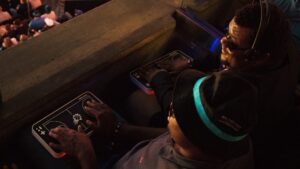Enhancing the Game: The Future of Accessible Sports Technology
At Extreme Investor Network, we’re dedicated to bringing you cutting-edge insights from the world of business innovation. One fascinating development that has recently captured attention is the intersection of technology and accessibility in sports. As we delve into the latest advancements designed to create inclusive experiences for visually impaired fans, we highlight how startups like OneCourt are transforming live sports, one vibration at a time.
A Game-Changing Experience
Imagine being at a thrilling NBA game and feeling the excitement of a half-court shot even if you can’t see it. This was exactly the experience for Jordan Moon, a participant from Saavi Services for the Blind, who attended the recent match between the Phoenix Suns and the Minnesota Timberwolves. While he couldn’t see the game unfold, he could feel the action through a tactile tablet, a groundbreaking device created by Seattle-based startup OneCourt.
These tablets are more than just high-tech gadgets; they serve as a bridge, connecting blind and low-vision fans to the pulse of the game. By simulating the layout of the basketball court and vibrating to reflect the movement of the ball, these devices allow users to engage with the sporting event on a visceral level.
The Rise of Accessible Technology
OneCourt is leading the charge in making sports events more inclusive, aligning with a growing number of tech startups focused on accessibility. Their innovative devices, while still in the early stages of rollout, are creating a buzz across major leagues, including partnerships with Major League Baseball (MLB) and the Premier League.
As of mid-2024, over twenty professional sports franchises have collaborated with OneCourt to provide tactile tablets at games, enriching the experience for visually impaired fans. With the Portland Trail Blazers being the first team to offer these devices at all home games, the momentum is building, and more teams are set to follow suit.
Understanding the Technology
These tactile tablets are ingeniously designed to act like miniature basketball courts. They vibrate in real-time, letting users know the ball’s location, scoring attempts, and fouls through a combination of tactile responses and audio feedback. The commitment to creating an inclusive experience is evident; countless hours of user testing and collaboration with blind and visually impaired individuals have gone into refining these devices.
Kunal Mehta, OneCourt’s user experience designer, emphasizes the importance of user comfort and accessibility in design. The goal is not just to create a device that works but one that seamlessly integrates into the social atmosphere of live sports – allowing blind fans to cheer, engage, and enjoy the camaraderie that sports elicits.
Driving Sustainability in Accessibility
While the development of such exciting technologies is promising, concerns about sustainability loom large. Recent critiques highlight the risk of creating "disability dongles" – well-intended solutions that fail to provide lasting value. Both Scott Aller from Ticketmaster and Jerred Mace of OneCourt have expressed a commitment to long-term viability, focusing on the delivery of continuous value to fans through ongoing partnerships and innovative updates.
Key aspects to ensure the longevity of these devices include integrating them into home environments. By developing a model that extends accessibility beyond event venues, OneCourt aims to ensure that fans can tap into the excitement of sports from their homes by 2026.
Addressing User Feedback and Challenges
Initial feedback from users has been largely positive, with many expressing thrill at experiencing the game’s depth in a new way. However, there’s also acknowledgment that improvements are needed. Suggestions to connect tablets to radio broadcasts, streamline usability for disabled users, and enhance portability are all areas of ongoing development.
As we look toward the future, the commitment of organizations like Saavi, sports teams, and tech startups to foster an inclusive sporting culture remains strong. There’s a collective recognition that while strides have been made, the journey toward full accessibility in sports is ongoing.
Conclusion: The Future of Sports is Inclusive
At Extreme Investor Network, we believe that the intersection of technology and accessibility isn’t just a trend — it’s a vital evolution in how we experience sports. As we continue to spotlight these advancements, our mission remains clear: to empower our community with insights that drive innovation, investment, and inclusion in every arena. The future of sports viewing shouldn’t just be about seeing it – but feeling it and living it, no matter who you are.
Stay tuned as we explore more incredible developments shaping the world of business and investment in tech!

